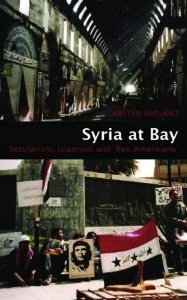Syria at Bay: Secularism, Islamism and Pax Americana
By Carsten Wieland
London: Hurst & Co, 2006
 Evening, April 27, 2004: a car with Saudi Arabian license plates races down a street in Mezzeh, the elegant uptown neighborhood of Damascus. The driver then attempts an illegal U-turn, catching the attention of a policeman. The cop tries to intercept the car. Its passengers open fire. The twenty-one-year-old police officer is shot in the chest and dies on the spot. Moments later, the Mezzeh expressway turns into a battlefield. Grenades are hurled and windowpanes shatter. Gunshots seem to come from every direction. As per their usual procedure, the authorities cut the telephone lines. Electricity is shut off. At 8:40 p.m., only seventy minutes after the attack, the authorities have control over the situation. (…).
Evening, April 27, 2004: a car with Saudi Arabian license plates races down a street in Mezzeh, the elegant uptown neighborhood of Damascus. The driver then attempts an illegal U-turn, catching the attention of a policeman. The cop tries to intercept the car. Its passengers open fire. The twenty-one-year-old police officer is shot in the chest and dies on the spot. Moments later, the Mezzeh expressway turns into a battlefield. Grenades are hurled and windowpanes shatter. Gunshots seem to come from every direction. As per their usual procedure, the authorities cut the telephone lines. Electricity is shut off. At 8:40 p.m., only seventy minutes after the attack, the authorities have control over the situation. (…).
Originally published in German in 2004, and fully revised for the English edition in 2005, Carsten Wieland’ s Syria at Bay describes a Syria that ceased to exist in March 2011. It would be wrong, however, to write it off as outdated. As we bear witness to the final days of the Ba’ath regime under the leadership of Bashar al-Assad and the violence that is sweeping across the country, speculations about the future of the country are rife. Who are the leaders of the opposition movement? What is the vision of the Free Syrian Army? Is the country likely to become a new theater of operations for al-Qaeda? Against the backdrop of the rising death toll and the debate over what is going on the ground, Wieland offers a nuanced insight into the complex make-up of Syrian society before it descended into chaos. Such insights will be of enormous value to anyone attempting to determine what the future might hold. In journalistic style, Wieland integrates a helpful examination of the role of secularism and Pan-Arabism into the discussion of the different voices within the growing opposition movement and maps the rivalry between Islamist factions while keeping a close eye on their relationships with the political elite. He chronicles President Assad’s increasingly difficult task of providing leadership and securing some sort of national unity while responding to international challenges, and identifies key mistakes that can be said with the benefit of hindsight to have marked the beginning of the end.
Although Wieland falls short of accurately predicting the future as it would unfold during the years following publication, Syria at Bay offers essential background information on the current political crisis in Syria in a comprehensive and accessible manner. For further reading, Wieland’s newly released Syria – A Decade of Lost Chances: Repression and Revolution from Damascus Spring to Arab Spring leads to additional discussion of more recent events regarding Syria.
—
Christina Hellmich is a Reader in International Relations and Middle East Studies at the University of Reading, UK. She is a specialist in Middle East politics (especially Yemen and the Arab Gulf) with a particular research interest in Political Islam, International Security and Global Health.
